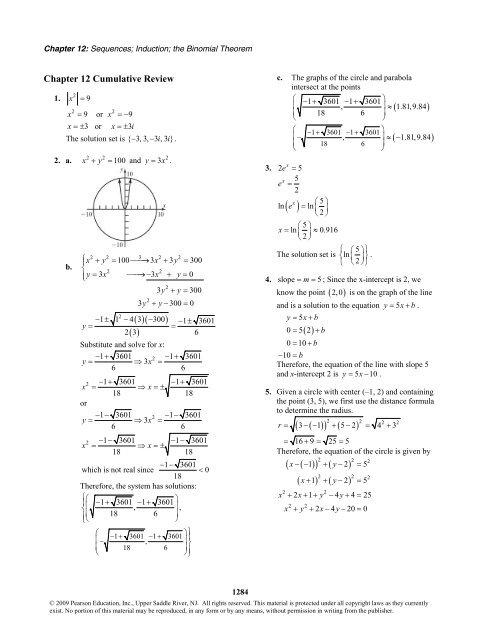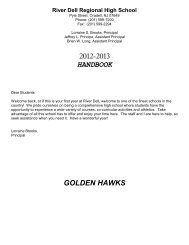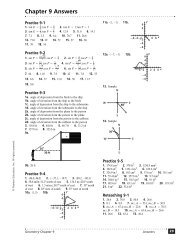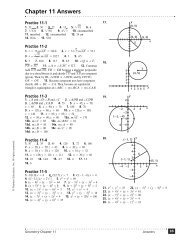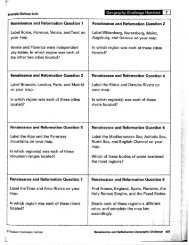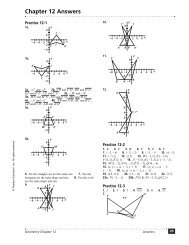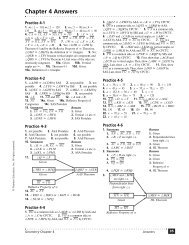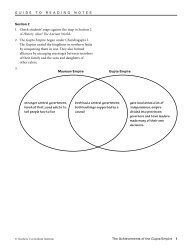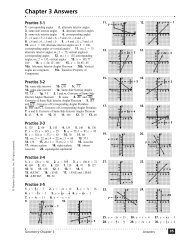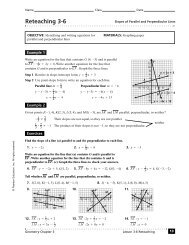Chapter 12 Sequences; Induction; the Binomial Theorem
Chapter 12 Sequences; Induction; the Binomial Theorem
Chapter 12 Sequences; Induction; the Binomial Theorem
You also want an ePaper? Increase the reach of your titles
YUMPU automatically turns print PDFs into web optimized ePapers that Google loves.
<strong>Chapter</strong> <strong>12</strong>: <strong>Sequences</strong>; <strong>Induction</strong>; <strong>the</strong> <strong>Binomial</strong> <strong>Theorem</strong><br />
<strong>Chapter</strong> <strong>12</strong> Cumulative Review<br />
1.<br />
2. a.<br />
2<br />
x = 9<br />
2 2<br />
x = 9 or x =−9<br />
x =± 3 or x =± 3i<br />
The solution set is { −3,3, − 3,3} i i .<br />
b.<br />
x<br />
2 2<br />
+ y = 100 and<br />
2<br />
y = 3x<br />
.<br />
2 2<br />
⎪<br />
⎧ x + y =<br />
3<br />
⎯⎯→<br />
2<br />
x +<br />
2<br />
y =<br />
2 2<br />
100 3 3 300<br />
⎨<br />
⎪⎩<br />
y = 3 x ⎯⎯→− 3 x + y = 0<br />
2<br />
3y<br />
+ y = 300<br />
2<br />
2<br />
3y<br />
+ y− 300=<br />
0<br />
( )( )<br />
( )<br />
− 1± 1 −4 3 −300 − 1±<br />
3601<br />
y = =<br />
23 6<br />
Substitute and solve for x:<br />
− 1+ 3601 2 − 1+<br />
3601<br />
y = ⇒ 3x<br />
=<br />
6 6<br />
2 − 1+ 3601 − 1+<br />
3601<br />
x = ⇒ x =±<br />
18 18<br />
or<br />
−1−<br />
3601 2 −1−<br />
3601<br />
y = ⇒ 3x<br />
=<br />
6 6<br />
2 −1−<br />
3601 −1−<br />
3601<br />
x = ⇒ x = ±<br />
18 18<br />
−1−<br />
3601<br />
which is not real since < 0<br />
18<br />
Therefore, <strong>the</strong> system has solutions:<br />
⎧⎛<br />
⎪ − 1+ 3601 − 1+<br />
3601<br />
⎞<br />
⎨ ⎜<br />
, ⎟ ,<br />
⎪ ⎜ 18 6 ⎟<br />
⎩ ⎝<br />
⎠<br />
⎛<br />
⎜−<br />
⎜<br />
⎝<br />
− 1+ 3601 − 1+<br />
3601 ⎞⎫<br />
, ⎟ ⎪ ⎬<br />
18 6 ⎟<br />
⎠⎭ ⎪<br />
c. The graphs of <strong>the</strong> circle and parabola<br />
intersect at <strong>the</strong> points<br />
⎛ − 1+ 3601 − 1+<br />
3601 ⎞<br />
⎜<br />
, ⎟≈ 1.81,9.84<br />
⎜ 18 6 ⎟<br />
⎝<br />
⎠<br />
⎛<br />
−<br />
⎜<br />
⎝<br />
x<br />
3. 2e = 5<br />
x 5<br />
e =<br />
2<br />
x ⎛5<br />
⎞<br />
ln ( e ) = ln ⎜ ⎟<br />
⎝ 2 ⎠<br />
⎛5<br />
⎞<br />
x = ln ⎜ ⎟≈0.916<br />
⎝2<br />
⎠<br />
− 1+ 3601 − 1+<br />
3601 ⎞<br />
, ⎟≈ −<br />
18 6 ⎟<br />
⎠<br />
⎧ ⎛5<br />
⎞⎫<br />
The solution set is ⎨ln ⎜ ⎟⎬<br />
⎩ ⎝ 2 ⎠⎭ .<br />
( )<br />
( 1.81,9.84)<br />
4. slope = m = 5 ; Since <strong>the</strong> x-intercept is 2, we<br />
know <strong>the</strong> point ( 2,0 ) is on <strong>the</strong> graph of <strong>the</strong> line<br />
and is a solution to <strong>the</strong> equation y = 5x+ b.<br />
y = 5x+<br />
b<br />
0= 5( 2)<br />
+ b<br />
0= 10+<br />
b<br />
− 10 = b<br />
Therefore, <strong>the</strong> equation of <strong>the</strong> line with slope 5<br />
and x-intercept 2 is y = 5x− 10.<br />
5. Given a circle with center (–1, 2) and containing<br />
<strong>the</strong> point (3, 5), we first use <strong>the</strong> distance formula<br />
to determine <strong>the</strong> radius.<br />
( ( )) ( )<br />
2 2 2 2<br />
r = 3− − 1 + 5− 2 = 4 + 3<br />
= 16 + 9 = 25 = 5<br />
Therefore, <strong>the</strong> equation of <strong>the</strong> circle is given by<br />
2 2 2<br />
x− − 1 + y− 2 = 5<br />
( ( )) ( )<br />
( x ) ( y )<br />
2 2 2<br />
+ 1 + − 2 = 5<br />
2 2<br />
x + 2x+ 1+ y − 4y+ 4=<br />
25<br />
2 2<br />
x + y + 2x−4y− 20=<br />
0<br />
<strong>12</strong>84<br />
© 2009 Pearson Education, Inc., Upper Saddle River, NJ. All rights reserved. This material is protected under all copyright laws as <strong>the</strong>y currently<br />
exist. No portion of this material may be reproduced, in any form or by any means, without permission in writing from <strong>the</strong> publisher.


